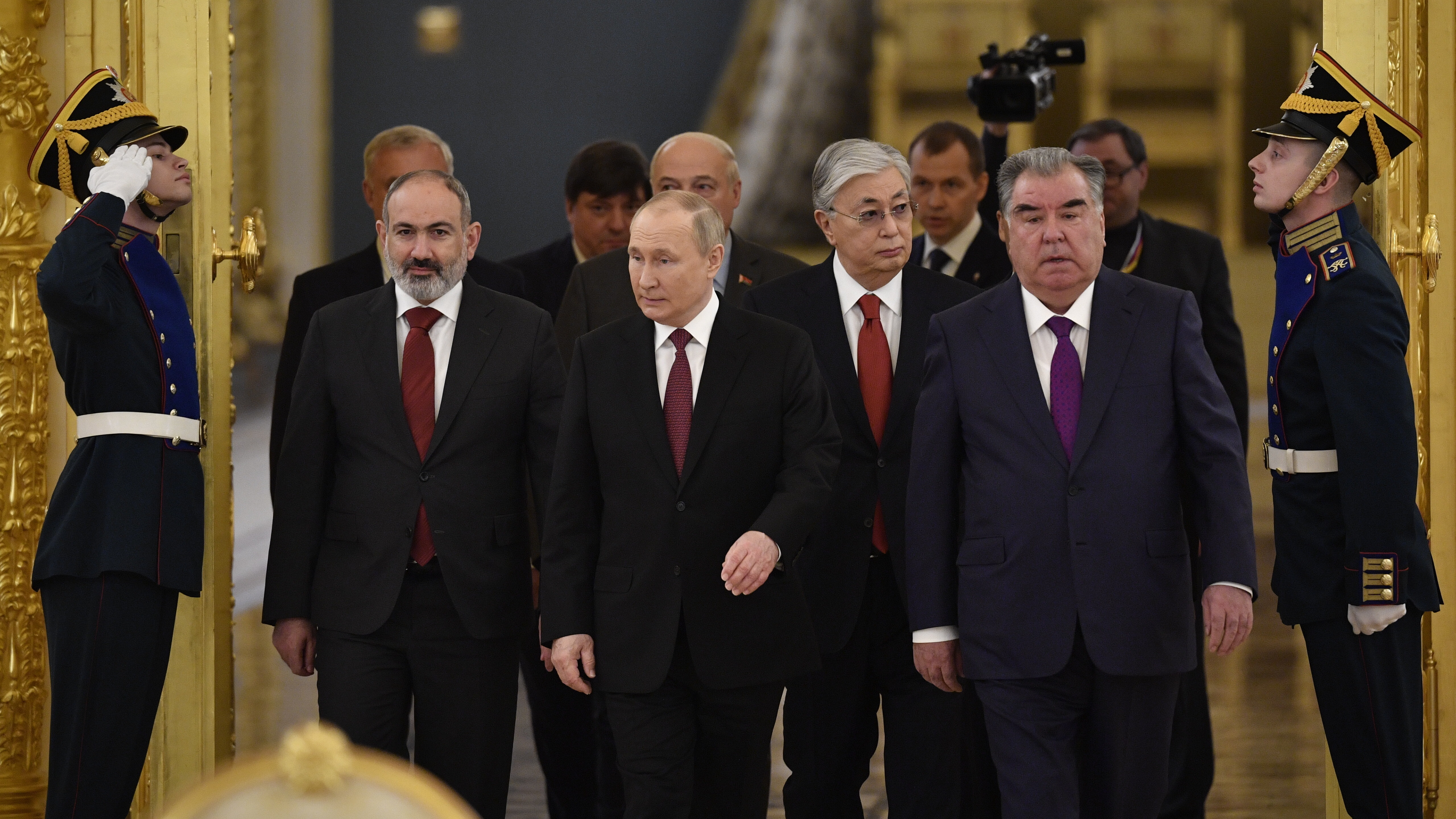Armenia
Armenia Leaving Russian-Lead CSTO?

From left, Armenian Prime Minister Nikol Pashinyan, Russian President Vladimir Putin, Kazakhstan's President Kassym-Jomart Tokayev and Tajikistan's President Emomali Rahmon enter a hall prior to a meeting of the leaders of the Collective Security Treaty Organization (CSTO) at the Kremlin in Moscow, Russia, Monday, May 16, 2022.
© picture alliance / ASSOCIATED PRESS | Alexander NemenovIn a speech in Parliament in June, Armenian Prime Minister Nikol Pashinyan announced that Armenia would leave the Russia-led Collective Security Treaty Organisation (CSTO). He did not provide details on when and how. From Yerevan, Areg Kochinyan discusses the risks Armenia may face by leaving CSTO and the opportunities that step can bring to Armenia.
What Drove Armenia's Decision?
According to the CSTO's Article 4, which forms the organization's base, an attack on any member state is considered an attack on the whole organization, and the member states are supposed to take immediate action, including military support, to defend their ally. This was exactly what happened in 2021 and 2022, right after the second Nagorno-Karabakh War in 2020. Throughout 2021 and 2022, Azerbaijan attacked Armenia proper several times to force Armenia to make certain concessions both to Azerbaijan on the Karabakh issue, and to Russia on the connectivity issue. Azerbaijan's main geopolitical goal was to gain full control over the self-proclaimed republic by compelling Armenia to recognize Karabakh as a part of Azerbaijan. This resulted in Azerbaijan launching a direct attack on Armenia in 2021, followed by a large-scale invasion in 2022 with bombardment and artillery shelling of Armenian cities and villages.
This occurred right after the colossal loss in the Nagorno-Karabakh War of 2020 - at Armenia's weakest point. Armenia applied to the CSTO for help (as well as to Russia specifically, based on the 1997 bilateral treaty on friendship, cooperation, and mutual assistance, formally obliging Russia to intervene in case of an attack on Armenia). Despite high expectations, Armenia got nothing tangible.
Meanwhile, the USA and the EU showed significant political engagement in stopping the Azerbaijani aggression. This included political pressure on Azerbaijan to stop the aggression, deployment of an EU monitoring mission on the Armenian border with Azerbaijan, and initiation of the Prague process, in which Armenia and Azerbaijan recognized each other's territorial integrity.
Russian Role and Its Consequences
The Azerbaijani attack was partly due to Russia's demands regarding Armenia's connectivity. It was not the first time Russia instrumentalized the Armenian-Azerbaijani conflict for its interests. This time, Russia wanted control over the so-called "Zangezur Corridor", a small part of Armenia that separates Azerbaijan from its landlocked enclave of Nakhichevan. Such control would give Russia a colossal advantage over Azerbaijan and Turkey and offer an alternative route to connect to southern markets, thus replacing the western ones.
Conversely, Armenia favors opening borders and enhancing connectivity without ceding its territory to anyone. In the summer of 2023, Armenia received a formal demand from Russia to transfer control of a piece of its territory to build a wall there (basically create an extraterritorial corridor): it was declined, and a month later, an Azerbaijani attack followed. Thus, not only did Armenia's formal ally fail to help Armenia during its darkest hour, but also this "ally" was one of the orchestrators of this "hour". Even more than that, in 2023, during his speech, Prime Minister Pashinyan mentioned that two "allies" of Armenia through CSTO were actively preparing and supporting Azerbaijan in its attacks against Armenia.
All this created an unprecedented political crisis in the relations between Armenia and Russia. Public opinion in Armenia shifted dramatically against Russia and CSTO. Traditionally, Russia had a positive reputation among Armenians, which was the foundation of its presence in the country. However, the number of Armenians who view Russia as their most important political partner declined from 88 percent in 2019 to 34 percent in 2023. This is the most significant shift in Yerevan's relations with Moscow - and one that might never be reversed.
What's Going on Now?
One element of the crisis between Yerevan and Moscow is Armenia's de-integration from CSTO. Armenia has not attended any organization-related event for over a year, including military drills and operations or meetings of the charter bodies and committees. Armenia recalled its permanent representative from CSTO's permanent council. Since 2024, Armenia has ceased its payments to the CSTO budget. It also canceled all CSTO activities planned on its territory and did not participate in the organization's decision-making process. Given all this, one might ask why Armenia doesn't formally leave the CSTO.
As it seems, the government wants CSTO to expel Armenia. Given Armenia's massive dependency on Russia, the final step – formally leaving the organization, would be a serious escalation of the situation on the Armenian side with possibly unmanageable consequences. Moscow has substantial influence over Armenia, extending beyond security matters.
Russia provides more than 90 percent of Armenia's natural gas and owns the country's gas pipeline infrastructure. It supplies all the uranium for Armenia's nuclear power plant. It is Armenia's biggest trade partner and the main destination for the country's exports. Russia owns Armenia's railroads and the majority of its electricity networks. It also has a huge presence in sectors like telecommunications, power plant management, and food security (e.g. it provides most of Armenia's grain imports). Russia also maintains a military presence in Armenia, with a military base in Gyumri and an air base in Erebuni. In addition, there are Russian border guards on Armenia's borders with Iran and Turkey. There was also a limited Russian presence on Armenia's border with Azerbaijan, but following Yerevan's demand, Moscow is now withdrawing the guards on the Armenia-Azerbaijan border. This process is expected to conclude by August.
This indicates Armenia's strategy is to create conditions under which Armenian participation is meaningless and harmful to the organization. In such a scenario, the CSTO's supreme body (the Collective Security Council, consisting of heads of member states) may opt to formally expel Armenia, which would formally mean Armenia is not the one escalating the situation.
While this strategy would help avoid the confrontation with Russia through Armenia's initiative, it still contains some significant risks. Currently, Armenia can leave the CSTO because of various factors, such as Russia's weakened position, western involvement, etc. However, that can change quickly, taking away the current opportunity. The absence of action right now might result in a missed momentum.
Areg Kochinyan is the President of the Research Center on Security Policy (RCSP), an Armenian think tank focusing on foreign affairs, security, resilience, regional and global politics. He runs Dilemma TV series on the issues of security and democracy.
